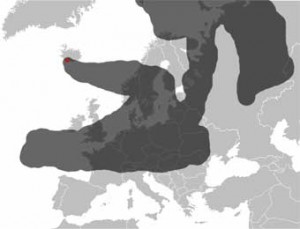On 14 April 2010 the Icelandic volcano Eyjafjallajökull erupted for a second time in two month after having been dormant for just under 200 years. The second eruption caused an ash plume that was ejected high into the stratosphere and transported by the wind to Northern and Western Europe. All of a sudden a commercial catastrophe hit Europe and all air traffic was completely shut down. The skies cleared of planes wary of flying through the high-altitude cloud of the volcano’s very corrosive dust which could damage delicate jet engines. As a result thousands of passengers got stranded around the globe. If it had not been for airplanes hardly anyone would have heard of the eruption but now it was front-page news. Continue reading
Tag: natural hazards

The Eyjafjallajökull ash cloud at 06:00 UTC
on 17 April 2010.
Source: Wikimedia Commons
On 14 April 2010 the Icelandic volcano Eyjafjallajökull erupted for a second time in two month after having been dormant for just under 200 years. The second eruption caused an ash plume that was ejected into the stratosphere and transported by the wind to Northwest Europe and all air traffic was shut down. As a result the eruption became a major news story. A secondary reason why the eruption became a major news story is the fact that volcanic ash clouds have not affected Europe in such an immediate way in living memory. But looking at the historical record of volcanic eruptions it becomes clear that these events have affected Europe and other parts of the world in significant ways and sometimes even altered the course of history. This extra edition of the Exploring Environmental History podcast considers a small sample of such volcanic event events, including the 536 AD dust veil event, the Black Death and the Laki eruption of 1783.
Resources and further reading
Nature as Historical Protagonist by Bruce M. S. Campbell, The Tawney Memorial Lecture 2008
Watch the lecture online
Gavin Schmidt, 536 AD and all that, RealClimate
L. B. Larsen et.al., “New ice core evidence for a volcanic cause of the A.D. 536 dust veil”, Geophysical Research Letters, Vol. 35, L04708, 5 PP., 2008.
R. A. Dodgshon, D. D. Gilbertson & J. P. Grattan, “Endemic stress, farming communities and the influence of Icelandic volcanic eruptions in the Scottish Highlands”, Geological Society, London, Special Publications; 2000; v. 171; p. 267-280.
Stephen Self, Icelandic eruptions, open2.net
In this episode Professor emeritus in history Christian Pfister, Fellow of the Oeschger Centre of Climate Research at the University of Bern examines the cultural memory of extreme weather events. In the past people experienced extreme weather in different ways depending on whether they lived in an agricultural society, an urban environment or in what profession they worked. Political and religious structures also influenced the response to weather related disasters. This coloured the narrative and memory of past extreme weather events and floods. Pfister demonstrates that this qualitative data is surprisingly objective and can be successfully used for climate reconstruction, producing surprising results.
Website mentioned in this podcast
Social, Economic and Environmental History Section, University of Bern (In German)
The inter-relationship of human beings and the natural world, and the influence of the physical environment on a community’s social and cultural development, is very well demonstrated in societies that face the persistent threat and reality of disasters. A prime example is the Philippines. Consisting of over seven thousand islands and located in an extremely hazard-prone area, the Philippines as a whole experiences more earthquakes, volcanic eruptions and tsunamis than any other country on earth. Although western social sciences typically depict “disasters” as abnormal occurrences, communities and individuals in the Philippines have come to accept hazard and disaster as a frequent life experience. Indeed, in a number of respects, Filipino cultures can be regarded as the product of community adaptation to these phenomena. This has consequences for the historical, social and cultural development of societies.
In this episode of the podcast Greg Bankoff, professor of modern non-western history at the University of Hull explores how the persistent threat and reality of disasters shapes the history, social and cultural development of societies.
Website mentioned in this podcast: University profile page of Professor Bankoff.
This podcast episode highlights two papers presented at a conference entitled “An End to History? Climate Change, the Past and the Future” that that was held at the Birmingham and Midland Institute in Birmingham on 3 April 2008. The papers presented addressed the issue what we can or can not learn from the experiences of past societies which have coped with climate or environmental change. In this episode Gill Chitty, Head of Conservation of The Council for British Archaeology, explores the important contributions that archaeology can make to the national debate about climate change. Jim Galloway of the Centre for Metropolitan History, Institute of Historical Research in London, reviews the evidence of the impact of storm surges on the lands bordering the Thames Estuary during the fourteenth century.
Website mentioned in this podcast:
Rescue!History, rescue-history-from-climate-change.org
© 2024 Environmental History Resources
Theme by Anders Noren — Up ↑
Recent Comments